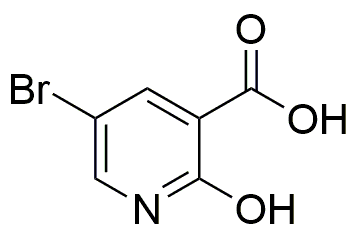5-Bromo-2-hydroxynicotinic acid is widely utilized in research focused on:
- Pharmaceutical Development: This compound serves as an important intermediate in the synthesis of various pharmaceuticals, particularly those targeting neurological disorders, due to its structural similarity to nicotinic acid.
- Biochemical Research: It is used in studies investigating the role of nicotinic receptors in cellular signaling, helping researchers understand mechanisms related to addiction and cognitive functions.
- Antioxidant Studies: The compound has shown potential antioxidant properties, making it a candidate for research aimed at developing new antioxidant therapies to combat oxidative stress-related diseases.
- Agricultural Applications: It can be explored for its effects on plant growth and development, potentially leading to the creation of novel agricultural products that enhance crop yield and resistance.
- Material Science: The compound’s unique properties allow it to be investigated for use in developing new materials, such as polymers or coatings, that require specific chemical functionalities.
General Information
Properties
Safety and Regulations
Applications
5-Bromo-2-hydroxynicotinic acid is widely utilized in research focused on:
- Pharmaceutical Development: This compound serves as an important intermediate in the synthesis of various pharmaceuticals, particularly those targeting neurological disorders, due to its structural similarity to nicotinic acid.
- Biochemical Research: It is used in studies investigating the role of nicotinic receptors in cellular signaling, helping researchers understand mechanisms related to addiction and cognitive functions.
- Antioxidant Studies: The compound has shown potential antioxidant properties, making it a candidate for research aimed at developing new antioxidant therapies to combat oxidative stress-related diseases.
- Agricultural Applications: It can be explored for its effects on plant growth and development, potentially leading to the creation of novel agricultural products that enhance crop yield and resistance.
- Material Science: The compound’s unique properties allow it to be investigated for use in developing new materials, such as polymers or coatings, that require specific chemical functionalities.
Documents
Safety Data Sheets (SDS)
The SDS provides comprehensive safety information on handling, storage, and disposal of the product.
Product Specification (PS)
The PS provides a comprehensive breakdown of the product’s properties, including chemical composition, physical state, purity, and storage requirements. It also details acceptable quality ranges and the product's intended applications.
Certificates of Analysis (COA)
Search for Certificates of Analysis (COA) by entering the products Lot Number. Lot and Batch Numbers can be found on a product’s label following the words ‘Lot’ or ‘Batch’.
Numéro de catalogue
Numéro de lot/série
Certificates Of Origin (COO)
This COO confirms the country where the product was manufactured, and also details the materials and components used in it and whether it is derived from natural, synthetic, or other specific sources. This certificate may be required for customs, trade, and regulatory compliance.
Numéro de catalogue
Numéro de lot/série
Safety Data Sheets (SDS)
The SDS provides comprehensive safety information on handling, storage, and disposal of the product.
DownloadProduct Specification (PS)
The PS provides a comprehensive breakdown of the product’s properties, including chemical composition, physical state, purity, and storage requirements. It also details acceptable quality ranges and the product's intended applications.
DownloadCertificates of Analysis (COA)
Search for Certificates of Analysis (COA) by entering the products Lot Number. Lot and Batch Numbers can be found on a product’s label following the words ‘Lot’ or ‘Batch’.
Numéro de catalogue
Numéro de lot/série
Certificates Of Origin (COO)
This COO confirms the country where the product was manufactured, and also details the materials and components used in it and whether it is derived from natural, synthetic, or other specific sources. This certificate may be required for customs, trade, and regulatory compliance.


